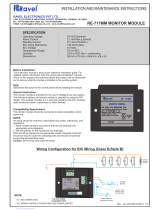
3
PFC-4064• 5403638 • REV E • 1/22
Table of Contents
Section 1: Introduction ............................................................................................................................. 1-1
Purpose of This Manual ..........................................................................................................................1-1
System Overview ....................................................................................................................................1-1
System Features ......................................................................................................................................1-1
P-Link Accessories ............................................................................................................................1-1
How to Use this Manual .........................................................................................................................1-2
Common Terminology ............................................................................................................................1-2
Section 2: Before You Start Installation .................................................................................................. 2-3
System Specications .............................................................................................................................2-3
Environmental Specications .................................................................................................................2-3
Model / Available Cabinet Colors ........................................................................................................... 2-3
System Congurations / Appliances .......................................................................................................2-3
Electrical Specications ..........................................................................................................................2-4
System Size Specications .....................................................................................................................2-4
Main Board Wiring Specications ..........................................................................................................2-4
Circuit Separation .............................................................................................................................2-4
Wiring Types ......................................................................................................................................2-4
Cabinet Dimensions ................................................................................................................................2-5
Cabinet Mounting Instructions ...............................................................................................................2-6
Cabinet Wiring Connections ...................................................................................................................2-7
Battery Circuit Calculations ....................................................................................................................2-8
Battery Connections ................................................................................................................................2-9
Section 3: Installation ............................................................................................................................. 3-10
Initiating Device Circuit Installation ....................................................................................................3-10
Notication Appliance Circuits Installation .......................................................................................... 3-11
NAC Wiring Characteristics ...........................................................................................................3-11
NAC Maximum Wiring Impedance Formula ..................................................................................3-11
NAC Wiring Conguration .............................................................................................................3-11
Municipal Box Connection ...................................................................................................................3-12
Conguration Characteristics ........................................................................................................3-12
Auxiliary Power ....................................................................................................................................3-13
Relay Output Wiring .............................................................................................................................3-13
Relay Characteristics ............................................................................................................................3-13
Class A Expander Installation (CA-4064) .............................................................................................3-14
Conguration Characteristics ........................................................................................................3-17
Maximum Wire Resistance Formula ...............................................................................................3-17
Addressing P-Link Modules .................................................................................................................3-19
P-Link Addresses .............................................................................................................................3-19
Module Installation ...............................................................................................................................3-20
Initiating Device Circuit Module - IDC-6 .......................................................................................3-20
Setting Address ................................................................................................................................3-21
IDC-6 Wiring Conguration ...........................................................................................................3-21
Remote Annunciators Installation ........................................................................................................3-24
UD-1000/UD-2000 (DACT) Installation ..............................................................................................3-24
P-Link & Dip Switch Locations ......................................................................................................3-26
LED Annunciators Installation (LED-16) .............................................................................................3-27






















